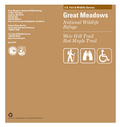Great Meadows Visitor Guide
Stretching along 12 miles of the Concord and Sudbury Rivers the rich river floodplain provides nesting, resting, and feeding habitat for wildlife, with special emphasis on migratory birds.
Great Meadows provides numerous recreation opportunities to thousands of visitors every year. People enjoy viewing the unique geology and diverse wildlife, whether boating, driving or hiking. Regulation of recreation activities allow for public enjoyment of the refuge while still protecting the wildlife and habitats. The Refuge consists of two main units: Sudbury and Concord.
Trail Maps
The refuge is open from sunrise to sunset. Visitors access the Sudbury Unit from the Refuge headquarters at 73 Weir Hill Road in Sudbury. The entrance gates to the unit close automatically ½ hour after sunset. Roads throughout the refuge are graveled and visitors must maintain the posted speed limit of 25 miles per hour. Parking is allowed in designated parking areas only. No overnight parking is allowed on the refuge.
Wildlife-dependent recreation opportunities, including wildlife observation, photography, interpretation, and environmental education, are permitted on designated trails shown on the map. Fishing and hunting are allowed subject to refuge regulations, State and Federal laws and permit restrictions. The most active hunt period is during the shotgun deer season late November and/or into December. Most other times, hunt pressure is generally light. There is no hunting on Sundays. Please refer to the kiosk or the refuge website for more information about hunt seasons.
A good place to start your walk is from the observation deck at the main building. From here, you have an excellent view of the Sudbury River and its floodplain ‘meadow’ covered in buttonbush, a native shrub which is a valuable part of the wetland floodplain ecosystem. The submerged part of these plants provides habitat for many small invertebrates. These in turn are a food source for fish, frogs, and birds. The seeds of the buttonbush are also eaten by birds, and the bush itself is used for nesting by many bird species.
The refuge is open from sunrise to sunset. Visitors access the Concord Unit via Monsen Road. The entrance gates to the unit close automatically ½ hour after sunset. Roads throughout the refuge are graveled and visitors must maintain the posted speed limit of 25 miles per hour. Parking is allowed in designated parking areas only. No overnight parking is allowed on the refuge.
Wildlife-dependent recreation opportunities, including wildlife observation, photography, interpretation, and environmental education, are permitted on designated trails shown on the map. Fishing and hunting are allowed subject to refuge regulations, State and Federal laws and permit restrictions. The most active hunt period is during the shotgun deer season late November and/or into December. Most other times, hunt pressure is generally light. There is no hunting on Sundays. Please refer to the kiosk or the refuge website for more information about hunt seasons.
The 2.7 miles of trails within the unit, including the Dike, Timber, Edge, and Black Duck Creek trails go through a variety of habitats that harbor various species including a variety of migratory waterfowl and breeding marsh birds.


